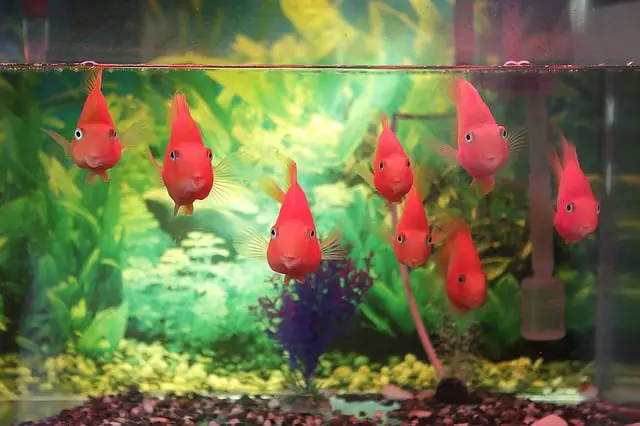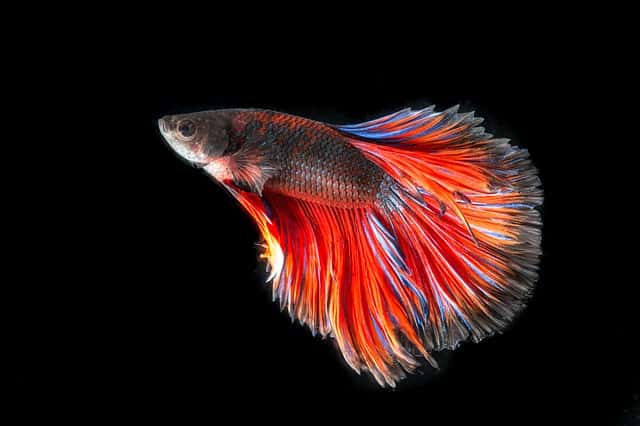Fish keeping is a visual hobby and to fully enjoy your tank, you need clean, clear water. Cloudy water in a fish tank typically indicates one of two things happening with the water. Luckily, they are both fairly easy fixes so you can get back to enjoying your clear tank as soon as possible!
Fish tanks will get cloudy when there is a bacterial bloom in an established tank or when the tank is going through the nitrogen cycle, such in the case of new tanks. Decaying plants or uneaten food can also result in cloudy aquarium water.
Now that you know the two main causes of a cloudy tank, let us take a closer look at this topic in more detail below. In the article, I will explain why fish tanks get cloudy after water changes, how long it takes to clear cloudy aquarium water, and whether (or not) cloudy water is bad for fish.
So, if you want to learn more, then please read onward!
Why does a Fish Tank get Cloudy after a Water Change?
Aquarium water can appear cloudy after performing a partial water change. When the substrate is disturbed during the cleaning process, it can make the water appear dirtier than it was before! This is only temporary, however, and will not harm your fish or other tank inhabitants.
Aquarium water can also appear cloudy after a tank top-up! Heavy sediment or minerals from hard water is often the cause. To prevent this, you should treat the water with a conditioner or dechlorinator before adding it to the tank. Better yet, use reverse osmosis water for tank top-ups whenever possible.
How Long does it Take for Cloudy Tank Water to Clear?
The amount of time it takes for cloudy aquarium water to clear up is dependent on the cause. A new tank needs to go through the initial nitrogen ‘break-in’ cycle, which could take several weeks (even months) to become crystal clear.
A bacterial bloom in an established tank is yet another reason for cloudy water. Two to four days after adding fish to an aquarium could result in ‘milky’ tank water. This cloudy, white appearance caused by the initial growth of bacteria is not harmful to fish and should clear up within a week to ten days.
Performing a partial water change can also make for cloudy aquarium water. This is only temporary, however, and will not harm the fish of other tank inhabitants. If you do 25 to 40 per cent water changes weekly, the tank should clear up within a day or two.
Why does an Established Aquarium Get Cloudy Water?
Bacterial bloom is the number one cause of cloudy water in an established aquarium. This usually occurs after a few weeks (or maybe even a few months) after the initial set-up and following the introduction of fish to the tank.
In time, the milky appearance of the water should resolve itself and become crystal clear! If not, it may be time to clean out any decaying plant or food matter from the substrate. Use an aquarium vacuum to remove any (and all) waste material from the sand or gravel at the bottom of the tank.
Check out the following aquarium vacuum available online through Amazon.
Is Cloudy Water Bad for Fish?
In most cases, cloudy water is not bad for fish. It is usually the result of a bacterial bloom (which is natural) or the after effect of a partial water change. When it becomes dangerous is during the nitrogen cycling process. If the nitrite levels are too high, water becomes toxic and can kill your fish!
It takes a newly established tank a month to generate enough bacterial colonies to clear the waste from the water naturally. During this time, it is imperative that you monitor the nitrite levels daily, which should be between 5 and 10 ppm. Anything higher and the aquatic environment becomes toxic for fish.
How do You Get Rid of Bacterial Bloom in Your Fish Tank?
One way to rid your tank of bacterial bloom is to add activated carbon media or carbon pads to your aquarium filter. These work to absorb the nutrients in the water that feed the bacterial bloom, thus helping to keep it clean and clear.
Activated carbon will last longer when placed after your mechanical filter. You want to ensure that all debris (fish waste, decaying plants, excess food particles, etc.) is removed beforehand, otherwise the carbon media will not work as effectively.
Check out the following carbon filter media and/or carbon pads available online through Amazon.

What is the White Fuzzy Stuff in My Fish Tank?
White, fluffy, or fuzzy debris floating around in your aquarium is usually the result of a fungal infection in fish, which can then leach into the water and make it appear cloudy. Causes are often related to poor water quality, excess amounts of decomposing organic matter in the tank, or sick/dying fish.
To remedy a fungal infection or ‘cotton wool disease’, try adding some freshwater aquarium salt to the tank. If you know which fish is infected, you can remove it from the community tank and place it in a quarantine or hospital tank. Isolating the sick fish and then treating it is the preferred course of action.
How to Fix Cloudy Fish Tank Water?
There are at least eight things you can do to fix cloudy fish tank water. These include the following:
- Perform weekly partial water changes – remove at least 25% of the existing tank water and topping it up with treated tap or reverse osmosis water.
- Add live plants to the tank – greenery contains ‘good’ bacteria and other microbes that help absorb ammonia from the water while maintaining the biological balance in the aquarium.
- Limit the amount of food you feed your fish to every second day – overfeeding fish creates more waste in the tank, which in turn makes the water cloudy (and possibly even dangerous).
- Do not overpopulate your tank – too many fish in an aquarium not only increases waste material but also raises the nitrite and ammonia levels in the water.
- Add activated carbon media/carbon pads to the tank – carbon helps keep aquarium water clear but absorbing the nutrients that feed bacterial bloom.
- Seed the tank – if you have another tank that is healthy and well-established, take some of the gravel from that tank and add it to the newer tank to ‘seed’ the bacterial bloom and speed-up the clearing process.
- Test the tank water regularly – as soon as you notice the water in your aquarium getting cloudy, begin testing it for ammonia and nitrites, which should be between 0 and 5 ppm’s ideally.
- Use reverse osmosis water whenever possible – RO water is devoid of minerals, which can make aquarium water appear dirty or cloudy. If you do not have access to reverse osmosis water, then be sure to treat your tap water with a conditioner/dechlorinator before adding it to the tank.
How to Get Your Aquarium Water Crystal Clear Again?
Whitish or greyish tank water is likely the result of gravel residue and occurs an hour or two after filling your aquarium. If the gravel was not washed thoroughly, then the water will appear cloudy. To fix this problem, simply drain the tank and rinse the gravel for as long as it takes until the water runs clear.
An excess of dissolved constituents (phosphates, silicates, and heavy metals) in a new aquarium can also make the tank water appear cloudy. Treating tap water with a dechlorinating conditioner should resolve the issue. Using reverse osmosis water instead is an even better option.
If your tank water appears green instead of clear, then it is likely due to algae overgrowth. Limiting the amount of light in the aquarium by shortening the duration and/or reducing the intensity should help. In addition, doing a partial water change as well as scraping the sides of tank is recommended.
Conclusion
To conclude, a bacterial bloom in an established tank will often cause the water to look cloudy. As well, a new tank going through the nitrogen cycle will make the water appear milky. If the tank has an excess of decaying plant or food matter embedded in the substrate, this too will make the water look whitish.
I hope this article has provided you with the information you seek regarding cloudy tank water. Thank-you for reading and good luck with your aquarium hobby.
Related Posts
How do you cycle an aquarium – The Nitrogen Cycle
Why is My Fish Tank Water Yellow? (Causes and the Solutions)
Why Does My Fish Tank Water Keep Going Green?






